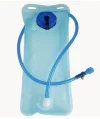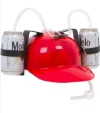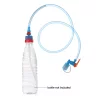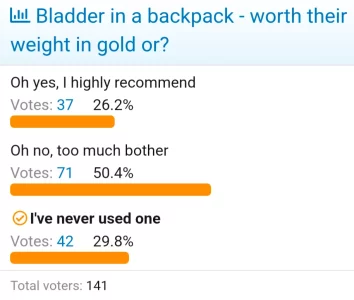-
Remove ads on the forum by becoming a donating member. More here.
Search 74,075 Camino Questions
You are using an out of date browser. It may not display this or other websites correctly.
You should upgrade or use an alternative browser.
You should upgrade or use an alternative browser.
Worth their weight in gold or 'don't bother' ?
- Thread starter RobinGore
- Start date
-
- Tags
- water/hydration
The 2024 Camino guides will be coming out little by little. Here is a collection of the ones that are out so far.
- Time of past OR future Camino
- Frances\Finisterre 22 Frances 26 del Norte 27
...and ship it to Santiago for storage. You pick it up once in Santiago. Service offered by Casa Ivar (we use DHL for transportation).
- Time of past OR future Camino
- Olvidado/San Salvador/Primitivo 2019
For the same reasons as stated above. Plus, I can comfortably walk all day without eating but would not do well in the Spanish heat without drinking and a bladder ensures I stay hydrated.
- Time of past OR future Camino
- 2016, 2022, 2023, 2024, planned 2025
Prefer water bottles.
The one from Galicia (the round) and the one from Castilla & Leon. Individually numbered and made by the same people that make the ones you see on your walk.
- Time of past OR future Camino
- Frances 15,16,18
VdlP 23, Invierno 23, Fisterra 23
I have used both bladders and bottles with drinking tube.
Ensuring adequate hydration is essential, and both methods allow for sufficient water to be carried.
By using a drinking tube, both methods allow for easy water access.
But which one allows for easy monitoring of consumption and water levels?
Front mounted water bottles….
For that reason alone I don’t use bladders any more.
On longer stretches, or more remote Caminos I would be forever digging into my pack to check water levels. That fear of running out, when using a bladder, caused me to carry too much water (weight).
Front mounted bottles, always in sight, allow precise monitoring, and I find encourages better hydration. I can drink to my planned consumption level freely, without worrying about how much water remains.
I loved bladders initially, but no way I would use them again.
I now remain fully hydrated, and don’t run out. (and don't end up carrying extra water)
Ensuring adequate hydration is essential, and both methods allow for sufficient water to be carried.
By using a drinking tube, both methods allow for easy water access.
But which one allows for easy monitoring of consumption and water levels?
Front mounted water bottles….
For that reason alone I don’t use bladders any more.
On longer stretches, or more remote Caminos I would be forever digging into my pack to check water levels. That fear of running out, when using a bladder, caused me to carry too much water (weight).
Front mounted bottles, always in sight, allow precise monitoring, and I find encourages better hydration. I can drink to my planned consumption level freely, without worrying about how much water remains.
I loved bladders initially, but no way I would use them again.
I now remain fully hydrated, and don’t run out. (and don't end up carrying extra water)
Last edited:
roving_rufus
Veteran Member
- Time of past OR future Camino
- Frances (2013-2015) Portugues (2017-2019) Via Francigena (2018-??) Camino from Ireland (2020-??)
Definitely water bottles- easier to see what I have drunk and what is left. Easier to wash and clean. And easy to replace if they get damaged or are leaking.
- Time of past OR future Camino
- CF 2023 sept/Oct
Primitivo July 2024
Bottles (obviously reusable) every time.
The one from Galicia (the round) and the one from Castilla & Leon. Individually numbered and made by the same people that make the ones you see on your walk.
- Time of past OR future Camino
- Many
I started with bladders, but switched to a sturdy bottle. The bladder is easier to drink out of, which is very good. But the bottle is much easier to refill.
I also buy some of those tasty vitamin tablet tubes that you can get from the pharmacy... the effervescent kind. That way when I find a fountain that tastes a bit too metallic for my liking I can spice it up.
I also buy some of those tasty vitamin tablet tubes that you can get from the pharmacy... the effervescent kind. That way when I find a fountain that tastes a bit too metallic for my liking I can spice it up.
bestfootforward
Member
- Time of past OR future Camino
- 2018, 2024, next 2025
Bottles, bottles, bottles. Easier to use, fill, clean and know how much water you have
- Time of past OR future Camino
- Past: a few. Last: Gudbrandsdalsleden. Next: TBC
I do both. Bladder for ease of drinking, weight balance, etc when walking. Small bottle as a reserve to refill the bladder if I drink all its contents, for a hydration mix at the end of each day's walk, for treating water collected from an untreated source, and to have beside my bed during the evening. I have a bladder that doesn't need to be removed from my pack to refill it, and a fitting that can be used to replace the mouthpiece so that it can be refilled from a bottle, also while still in my pack.
I recommend using a bladder, but making sure you stay hydrated is more important than how you achieve that. Do something that works for you.
I recommend using a bladder, but making sure you stay hydrated is more important than how you achieve that. Do something that works for you.
A selection of Camino Jewellery
- Time of past OR future Camino
- Annually - often more - from 2014
I do both, but the other way round. 2x500ml bottles either side of my pack; easily accessible whilst walking, and 1-2l in a bladder under my pack lid as a reserve. Once I’m certain I’m within an hour or so of my end point the bladder contents get ditched.
- Time of past OR future Camino
- Us:Camino Frances, 2015 Me:Catalan/Aragonese, 2019
- Time of past OR future Camino
- 2016, 2022, 2023, 2024, planned 2025
I think it is kind of like shoes, rain ponchos vs rain coats, backpacks, and other items. It is extremely individual and a poll probably won't solve it for you.
Ideal sleeping bag liner whether we want to add a thermal plus to our bag, or if we want to use it alone to sleep in shelters or hostels. Thanks to its mummy shape, it adapts perfectly to our body.
€46,-
€46,-
- Time of past OR future Camino
- 2012, 2015, 2018, 2019, 2022, 2024
Absolutely. You're the one that is going to have to carry it. Go for a few long walks and try out both solutions and see which one works for you.I think it is kind of like shoes, rain ponchos vs rain coats, backpacks, and other items. It is extremely individual and a poll probably won't solve it for you.
- Time of past OR future Camino
- VdLP-Sanabres-Fisterra '15; Levante-Invierno '19
Depends on the route and the season. If the weather is hot, have at least one bladder.
If it is cool ie under 20 degrees bottles will suffice.
I used bladders on the VDLP in June/July and they were invaluable. Bottles on the Levante/Invierno in Feb/Mar as I didn't need to drink as much and there were more opportunities to stop for a coffee or drink.
Next Camino next May/June will be tubes on 2l soft bottles plus some extra in the front pockets depending on weather. We will be doing short stages however this time around.
If it is cool ie under 20 degrees bottles will suffice.
I used bladders on the VDLP in June/July and they were invaluable. Bottles on the Levante/Invierno in Feb/Mar as I didn't need to drink as much and there were more opportunities to stop for a coffee or drink.
Next Camino next May/June will be tubes on 2l soft bottles plus some extra in the front pockets depending on weather. We will be doing short stages however this time around.
- Time of past OR future Camino
- VdLP-Sanabres-Fisterra '15; Levante-Invierno '19
And I need my hands for my poles and my camera. Bladders let you use your hands for other things. But bladders can leak so I bring two.
...and ship it to Santiago for storage. You pick it up once in Santiago. Service offered by Casa Ivar (we use DHL for transportation).
- Time of past OR future Camino
- Frances 15,16,18
VdlP 23, Invierno 23, Fisterra 23
- Time of past OR future Camino
- Inglès April 2023
Primitivo July 2023
Actually, that's exactly what I do. Half litre bottle with tube attached stashed in pack to keep everything cool, 1 l bottle in reserve used exclusively for refilling aforesaid half litre.
- Time of past OR future Camino
- Frances 15,16,18
VdlP 23, Invierno 23, Fisterra 23
Actually, that's exactly what I do. Half litre bottle with tube attached stashed in pack to keep everything cool, 1 l bottle in reserve used exclusively for refilling aforesaid half litre.
I found last year, walking stages with no intermediate water points, that water management was essential.
Not wanting to carry extra weight in water, but carrying enough to be well hydrated.
Knowing my regular consumption is 10 kms / litre I could carry just the right amount and easily monitor consumption. Often reminding myself to drink more........
I never ran out. Or carried much excess.
Depending on the stage I usually carried 1.5 - 2.5 litres. a couple of days, 3 litres.
2 x 1 litre bottles on the front pack straps, always in sight with a drinking tube attached.
extra as required in my pack.
I never ran out.
And would finish most days with about 200-300 ml remaining in reserve.
I'd rather not be guessing how much water I have left.
Or find my water bladder has leaked. (It's happened)
Last edited:
Join the Camino cleanup. Logroño to Burgos May 2025 & Astorga to OCebreiro in June
bobojnr
New Member
- Time of past OR future Camino
- September 2023
Both. Done so many of my first hikes in Crete gorges and mountains so found the bladder particularly easy to use. It was also very conveniently filled up with Metaxa for the return trip; that is before the no liquid rule for hand luggage came in.
OZAJ
Active Member
- Time of past OR future Camino
- Mozarabe/VdlP/Sanabres (2008) Norte (2009) Vezelay/Frances/Salvador/Primitivo (2010) etc.
I used a bladder once. The lid broke.
I use half litre bottles distributed in my pack where they remain remarkably cool. Usually 2 litres.
Some say that storing the bottles inside the pack is a problem: you have to take the pack off to access the bottles. If you have a problem with that, bearing in mind that the water is likely to still be cool ...
I use half litre bottles distributed in my pack where they remain remarkably cool. Usually 2 litres.
Some say that storing the bottles inside the pack is a problem: you have to take the pack off to access the bottles. If you have a problem with that, bearing in mind that the water is likely to still be cool ...
Ideal pocket guides for during & after your Camino. Each weighs only 1.4 oz (40g)!
Sweething
New Member
- Time of past OR future Camino
- 2023
These are exactly what I used, (although I did use a bladder when I first started training). Best thing since sliced bread
Roland49
Veteran Member
- Time of past OR future Camino
- CF 07/2019, CP 07/2023
Never used a bladder and never will.
To much to care about. Especially in hot areas.
I'm a "camel" and even on hot days I rarely consume 1l of water while walking.
I fill up on the evening after I done all the necessary procedures of a long walk.
My "go-to" system are 2 half-litre single-use bottles. Sturdy, lightweight and cheap.
To much to care about. Especially in hot areas.
I'm a "camel" and even on hot days I rarely consume 1l of water while walking.
I fill up on the evening after I done all the necessary procedures of a long walk.
My "go-to" system are 2 half-litre single-use bottles. Sturdy, lightweight and cheap.
ShellToucher
Member
- Time of past OR future Camino
- Spring 22
Spring 23
Summer or Fall 24
Here is another hydration system that personally, I believe works better:
Train for your next Camino on California's Santa Catalina Island March 16-19
Jeff Crawley
Veteran Member
- Time of past OR future Camino
- A "Tourigrino" trip once Covid has passed, so 2023
Not forgetting to empty bladder . . .When walking, 3 things to not forget:
- drink water
- drink water
- drink water
Personally, I cannot manage to drink enough (especially if the weather is not hot) without a bladder.
Pilgrim Patricia
Want to do the VdlP again!
- Time of past OR future Camino
- Via de la Plata; Hospitalera Miraz 2011
Re-fillable bottles (one litre or smaller)! Given the opportunity I'll freeze one or two overnight so they can keep others cool.
Ideal pocket guides for during & after your Camino. Each weighs only 1.4 oz (40g)!
dbeatriceb
Active Member
- Time of past OR future Camino
- The most recent Camino we did was in 2017
I’ve used both and definitely prefer bottles over bladder.
Bladders offer a certain amount of convenience but, for me, cleanliness is an issue. That is where I find a bladder inconvenient.
Also, carrying a water bottle on the front attached to the backpack strap plus carrying an extra bottle in a side pocket distributes weight differently and takes just a little bit of the load off my back.
OSUbuckeye85
New Member
- Time of past OR future Camino
- 2025
What front-mounted water bottle do you use?I have used both bladders and bottles with drinking tube.
Ensuring adequate hydration is essential, and both methods allow for sufficient water to be carried.
By using a drinking tube, both methods allow for easy water access.
But which one allows for easy monitoring of consumption and water levels?
Front mounted water bottles….
For that reason alone I don’t use bladders any more.
On longer stretches, or more remote Caminos I would be forever digging into my pack to check water levels. That fear of running out, when using a bladder, caused me to carry too much water (weight).
Front mounted bottles, always in sight, allow precise monitoring, and I find encourages better hydration. I can drink to my planned consumption level freely, without worrying about how much water remains.
I loved bladders initially, but no way I would use them again.
I now remain fully hydrated, and don’t run out. (and don't end up carrying extra water)
JFG
Doing Caminos since 2003. Holy Cow!
- Time of past OR future Camino
- Frances, Portugues, Norte, Ignacio, Salvador, Tunnel, Ingles, and more...
Definite yes. I used this one from Amazon after using the more popular brands and it worked great, it was sturdy, easy to clean and inexpensive. Not the greatest color though.
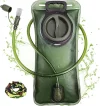
Hydration Bladder, 1.5L-2L-3L Water Bladder for Hiking Backpack Leak Proof Water Reservoir Storage Bag, BPA-Free Water Pouch Hydration Pack for Camping Cycling Running, Military Green 1.5-2-3 Liter
Train for your next Camino on California's Santa Catalina Island March 16-19
EWhite
Member
- Time of past OR future Camino
- no
Learn More — One Bottle Hydration™
The One Bottle Hydration System adds a convenient CamelBak style drinking tube to your wide mouth Nalgene or Hydro Flask. Put One Bottle into your pack instead of a hydration bladder and enjoy convenience plus versatility!
- Time of past OR future Camino
- 23:Valença Var Espiritual Apr; Norte Cudillero Oct
I find this kind of bladder system very difficult to use: unscrewing cap, water leaks out, need to get it out of backpack in order to fill…
I vote for this ingenious solution by Osprey (this is newest version): seals water tight, no spills, very easy to open, fill, and close. Once you get the hang of it, can fill it without getting it out of backpack but I prefer to pop it out and fill it from a faucet. Green arrow easy clip closing. Red circle easy to disconnect push button tubing.
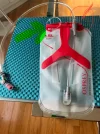
Last edited by a moderator:
pkonopka
Member
- Time of past OR future Camino
- 2022 Camino Frances; 2023 Camino Portuguese
Yes, get and use. Water bottles are fine but very inconvenient to use while walking. A good bladder (easy to fill, durable but light) is worth it.
€2,-/day will present your project to thousands of visitors each day. All interested in the Camino de Santiago.
- Time of past OR future Camino
- Camino Frances Leon to SDC Sept.2024
I went this past September and brought my bladder with full intention of using it. The weather was more mild than what was typical for this time of year. I ended up re-filling a plastic water bottle at our stops and I would drink one bottle of Aquarius as well. I used the bladder only once during the early days of the walk.
I did about 20 years of long distance cycling and skating when I was younger (40's-50's). Bladders were "all the rage" back then and I used them extensively. Watching the Tour de France one year, it dawned on me that if bladders were so great, why didn't the greatest use them?
Taking a clue from the "thru-hikers", I migrated to using various size screw-top bottles. I carry two-1 liter bottles and two-1/2 liter bottles. VERY seldom fill them all, but have on occasion. Empty they weigh very little. They can all be used with filters.
My pack has easily accessible angled side pockets and I fill bottles based on expected need for next interval.
I hated cleaning bladders and hoses
Taking a clue from the "thru-hikers", I migrated to using various size screw-top bottles. I carry two-1 liter bottles and two-1/2 liter bottles. VERY seldom fill them all, but have on occasion. Empty they weigh very little. They can all be used with filters.
My pack has easily accessible angled side pockets and I fill bottles based on expected need for next interval.
I hated cleaning bladders and hoses
Walkingat70
Member
- Time of past OR future Camino
- French Way March to April 2022
Portuguese Way from
I always use a water bladder. Got mine from Decathalon. 2 ltrs
€2,-/day will present your project to thousands of visitors each day. All interested in the Camino de Santiago.
Walkingat70
Member
- Time of past OR future Camino
- French Way March to April 2022
Portuguese Way from
I find the water bladder invaluable. Basically hands free.
Martin-B
Member
- Time of past OR future Camino
- Camino Frances, Oct 22
Another vote for bottles, just the ones you buy the water in, easily refillable, recyclable when you've finished. I carry a bottle or two on the pack and a 400/500 ml bottle on the shoulder strap for easy access, I look for bottles with a wider opening as they're easier to refill and they don't crumple up when you drink which means they last longer. 2 bottles lasted the entire Via Francigena and I'm still using them 18 months later for local walks. I did try the drinking tubes but found no real advantage over just drinking from the bottle. For me the secret is having a bottle that's accessible without stopping or having to remove the pack.
Train for your next Camino on California's Santa Catalina Island March 16-19
MichelleElynHogan
Veteran Member
The weight of a bladder is usually less than the equivalent size bottles etc. Plus, just pop the mouthpiece in and drink. It is a no brainer for me.
- Time of past OR future Camino
- CF, CP, VDLP, VK
Leaving aside hygiene it comes down to flexibility. I get two of the Powerade bottles on arrival- sturdier and good tops. If for any reason I need to carry more water I grab a liter bottle. They fit easily under any tap, fit neatly onto either side of my pack, am able to take one with me if needed. If one is damaged or needs replacement no dramas. Bladders are so inflexible and tend to be filled because of the hassle and so you end up carting around unnecessary weight. I get there are very loyal adherents but for a camino bottles are such a no brainer.
- Time of past OR future Camino
- Various routes 2016 - 2024
The Metaxa was for its antimicrobial properties, right?It was also very conveniently filled up with Metaxa for the return trip;
Bladders are not inherently less hygienic. So long as you are putting fresh water in them regularly they really don't need to be cleaned while on the trail.Bladders offer a certain amount of convenience but, for me, cleanliness is an issue. That is where I find a bladder inconvenient.
Here's a pretty extensive post from @davebugg
This post was written to dispel some common misinformation which is sometimes used to claim that hydration or water reservoirs/bladders are either less sanitary to use or are less convenient to use than bottles. Oft times there is a difference with which someone 'perceives' or approaches a products usability, but this is typically more of a subjective preference, than a real world objective and functional difference.
I'm NOT writing this post to suggest that I and others who prefer reservoirs are making the superior choice; I am posting this to preempt those who misstate facts, or who have insufficient facts to claim that using hydration reservoirs is the WRONG way to go.
1. Sanitation. With water carry, bottles have no advantage. Reservoirs stay just as sanitary. They do not require cleaning every day, nor do they need to be dried.
As with plumbing, it is the change of water and water flow through frequent use which keeps bottles, reservoirs, and tubing fresh and sanitary. With normal use, both bladders and bottles are constantly refilled and emptied That keeps them sanitary UNLESS contaminated water is introduced, or other fluids with sugars (juices, energy drinks, soda pop, etc.) are put into a bottle or a reservoir.
While working for a public health district, I did a review of the literature, which I again did in 2016 and 2022. Comparisons of bacterial contamination levels between bottles and hydration bladders were indistinguishable -- both had equally low rates of bacterial contamination. And both were at about equal risk for developing significant levels of bacteria and mold if not cleaned and dried properly prior to storage. In the last few years, the hydration reservoirs have become more modular in nature and have wider openings to access the water compartments, making it much easier to clean and prepare for storage than previous generations of the product.
One example study, from 2009:
https://www.wemjournal.org/article/S1080-6032(09)70419-3/fulltext
When it is time to store bottles or bladders away for the season, they can be sanitized if desired with a bit of bleach added to the final rinse water during cleaning. It is not necessary, but there is no harm in doing so. Then they can be rinsed out and be allowed to dry.
Molds and other nasty things occur if either container is stored with water over a period of time, or have contained other fluids which might have sugars and then are not properly washed out prior to long term storage. Mold may also form in the shorter term when fluids with sugars are exposed to warmth and sun.
Also, not all discolorations are harmful molds. Most times, it may be an algae growth from leaving stagnant water exposed to light.
2. Ease of Use. I find it personally easier to raise the mouth tube on my shoulder strap to drink from. I do not like to reach around to a side pocket, or even need to take off my pack to do so. I definitely do NOT like stuff hanging on my shoulder straps like bottles of water.
Again, this is personal preference, not an issue of something being 'better'. Access water bottles is not an issue of usability for bottle users.
3. Weight. Here is where two major claims are made, one is correct and the other is not.
A typical empty 2 liter reservoir weighs around 4 to 6 ounces. The equivalent in bottles around 1.5 to 3 ounces. Depending on bottle material used, though, bottles can weigh up to 8 ounces.
So while it is correct that bottles can weigh less, it is not a significant issue of consideration with overall backpack weight.
The other issue is reservoir water capacity and total weight.
You do not have to fill a reservoir to the tippy top. I will carry as much water as I need to carry from water source to water source. If the next water source is 32 kilometers distant under a hot sun, I will carry up to 4 liters. If the next water source is a few kilometers distant in cool weather, I might carry a half liter.
4. Refills. This is actually a subheading under 'ease of use', but it is frequently pointed to as why bottles are better than reservoirs.
I can refill my reservoir without even removing my backpack. One does not need to pull a reservoir out of the pack. It is a matter of using a quick disconnect system which is a simple and cheap add on accessory. My water filling process goes something like this if I want to refill or do a bit of a top off:
1. I pull the collapsible bottle from my side pocket and unscrew the Quick Disconnect lid from the bottle
2. I Fill the bottle and replace the Quick Disconnect lid.
3. Quick Disconnect the mouth piece from the feed tube and connect the water bottle to the feed tube.
4. Gently squeeze the water in the collapsible bottle into the feed tube, filling the water bladder.
5. Disconnect the bottle and reconnect the mouthpiece. Stow the water bottle
For those interested in adding a Quick Connect adapter to your hydration reservoir/bladder, I've added a link below. With the quick disconnect added, I don't even need to remove my backpack or daypack to do a quick and easy refill of the bladder.
NOTE: The video shows the quick disconnect being used with a water filter as used when wilderness backpacking. For a camino I leave off the filter altogether. The refill cap is simply attached to my collapsible water bottle, after it is filled with water from a fountain or faucet.
For refill bottles.... I use an extremely lightweight collapsible bottle (click the bold blue wording) that can hold up to 1.5 liters. Empty, it rolls down to a small bundle that are easily stashed in an outside pocket.
Many times, I will carry 1/2 liter in the collapsible bottle as a quick backup as the weather or the distance between water refills dictates. So, if I decide to, say, carry 1 liter of water between water resupply points, I will fill the reservoir with 1/2 liter, and then carry 1/2 liter in the bottle, keeping the bottle partially collapsed and tucked into a side pocket.
By doing the above I do not need to see the water bladder itself in order to be assured of adequate water or to avoid accidentally running out of water.
The collapsible bottle I use is just one container option. The refill adapter with the Quick Connect kit can also fit on a variety of empty bottled water containers.
So those are the major issues that always seem to come up. There are others, but those above are the major ones I keep seeing pop up..
Join the Camino cleanup. Logroño to Burgos May 2025 & Astorga to OCebreiro in June
kmrice
Active Member
- Time of past OR future Camino
- Podiensis 2016, Via Francigena 2018, '19, '22, '23
I use bottles. Tried bladder once on the Bright Angel Trail in the Grand Canyon. I thought it would help me stay hydrated. What I discovered was that even though I thought I was drinking a lot was that, at the end of the day, I had drunk a lot less than I thought. I went back to bottles; now I always know how much I have drunk.
We use Vapur brand bottles; they weigh almost nothing and when not in use can be rolled up into almost nothing so we carry several extras.
We use Vapur brand bottles; they weigh almost nothing and when not in use can be rolled up into almost nothing so we carry several extras.
I'm training with one at the moment - so far so good, not cumbersome at allWhen walking, 3 things to not forget:
- drink water
- drink water
- drink water
Personally, I cannot manage to drink enough (especially if the weather is not hot) without a bladder.
hahaha - that's the first thing I liked about it (the color) ... yah I'm training with one right now, so far it's okayDefinite yes. I used this one from Amazon after using the more popular brands and it worked great, it was sturdy, easy to clean and inexpensive. Not the greatest color though. View attachment 180372
Hydration Bladder, 1.5L-2L-3L Water Bladder for Hiking Backpack Leak Proof Water Reservoir Storage Bag, BPA-Free Water Pouch Hydration Pack for Camping Cycling Running, Military Green 1.5-2-3 Liter
A selection of Camino Jewellery
- Time of past OR future Camino
- Various routes 2016 - 2024
So long as you drink enough to satisfy your thirst and your urine passes the color test, why does it matter exactly how much you drink?use bottles. Tried bladder once on the Bright Angel Trail in the Grand Canyon. I thought it would help me stay hydrated. What I discovered was that even though I thought I was drinking a lot was that, at the end of the day, I had drunk a lot less than I thought. I went back to bottles; now I always know how much I have drunk
pjacobi
Active Member
- Time of past OR future Camino
- 2015, St. Jean Pied de Port to Burgos
2016, Burgos to Ponferrada
2017, Ponferrada to Atlantic Ocean
When walking, 3 things to not forget:
- drink water
- drink water
- drink water
This will result is "water poisoning" i.e. loss of electrolytes and low blood sugar.
You need to balance water intake with EATING healthy snacks contain salt and sugars to replace what has been burned and sweated away.
-Paul
obinjatoo
Veteran Member
- Time of past OR future Camino
- 2012 Dieppe, FR Bici CF.
2014 Ruta Vasco/CF/Primativo
I like mine..
...and ship it to Santiago for storage. You pick it up once in Santiago. Service offered by Casa Ivar (we use DHL for transportation).
- Time of past OR future Camino
- Frances\Finisterre 22 Frances 26 del Norte 27
IMHO drinking is also some form of self-control. I am notoriously guilty of not drinking enough water during my 'regular' days. Somehow I've learnt to know better when i walk. I trained myself to take that pull on the tube within some time. I trained for it some years ago by setting up an alarm in my phone that "yelled" at me every 15 mins "DRINK WATER!" and sort of got into a habit...What I discovered was that even though I thought I was drinking a lot was that, at the end of the day, I had drunk a lot less than I thought. I went back to bottles; now I always know how much I have drunk.
Yeah I heard about it on the Camino from one Belgian Lady. Although she absolutely seriously told me that if you drink 10L of water you will die.This will result is "water poisoning" i.e. loss of electrolytes and low blood sugar.
You need to balance water intake with EATING healthy snacks contain salt and sugars to replace what has been burned and sweated away.
-Paul
- Time of past OR future Camino
- Various routes 2016 - 2024
Quite possible if you were to drink that much water in a short amount of time.Yeah I heard about it on the Camino from one Belgian Lady. Although she absolutely seriously told me that if you drink 10L of water you will die.
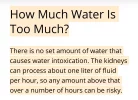

Can You Drink Too Much Water?
We often hear about the importance of drinking plenty of water. But did you know that drinking too much water can be bad for your health?
- Time of past OR future Camino
- Frances 15,16,18
VdlP 23, Invierno 23, Fisterra 23
Any store water bottle you like!What front-mounted water bottle do you use?
Held on with a water bottle clip and using a drinking tube.
Hands free water…..hands free umbrella….
€2,-/day will present your project to thousands of visitors each day. All interested in the Camino de Santiago.
I usually carry at lest three 1/2 L bottles. One in a front fanny pack with a bottle pocket in my waist, easy to access, and the others in the backpack. It is always good to remove the backpack once in a while, so I change bottles in that moment.
happymarkos
HappyMark
- Time of past OR future Camino
- 2023. Finish the VDLP. Zamora to Santiago.
I have walked with and without the bladder.
I am a NO
reasons
1 you can sip but don’t know how much you have consumed. Can be way out
2 difficult to refill
3 if it’s 2-3 l that’s a lot of weight. 2-3 kgs
4 in many parts of the Camino there is abundant water. Even heading over the Pyrenees there are 3 places to top up.
5 a 500ml water bottle on each hip provides balance and usually enough.
Yes there are exceptions such as long stretches on the VDLP. Then you need a different strategy
My advice is to keep the weight down and check each days distance and plan water appropriately
Cheers
Mark O
BTW, This spring I carried a "Life Water" disposable bottle that had a sticker on it from my 2018 Frances Camino. Throw in 4 months on the AT and a couple other months on trail and I think they last very well 
Join the Camino cleanup. Logroño to Burgos May 2025 & Astorga to OCebreiro in June
- Time of past OR future Camino
- Frances 15,16,18
VdlP 23, Invierno 23, Fisterra 23
Sorry to labour the point, but an analogy came to me. 
Using a water bladder in your pack, as opposed to a water bottle 'that is in sight' (ie front mounted)
Is rather like driving a car with no fuel tank gauge.........
Maybe you would fill up with extra fuel 'just in case' or go 'easy on the gas' just in case?
Whatever............you're guessing to some extent.
Using a water bladder in your pack, as opposed to a water bottle 'that is in sight' (ie front mounted)
Is rather like driving a car with no fuel tank gauge.........
Maybe you would fill up with extra fuel 'just in case' or go 'easy on the gas' just in case?
Whatever............you're guessing to some extent.
- Time of past OR future Camino
- Frances 15,16,18
VdlP 23, Invierno 23, Fisterra 23
The weight of a bladder is usually less than the equivalent size bottles etc. Plus, just pop the mouthpiece in and drink. It is a no brainer for me.
My 2L water bladder weighs 165 gms.
My 2 x 1L bottles weigh 50 gms.
Though to be fair in comparison, my drinking tube weighs 70 gms.
I just 'pop' in the mouthpiece and drink
It's not so much about the weight.
Though bottles are lighter.
They have the same convenience, using a tube.
For me it's all about visibility.
I have a 'water gauge' sitting in front of me.
But hey, like any other gear, we all have our preferences.
Though I'm surprised I don't see many people using a drinking tube with bottles?
DanielleC
New Member
- Time of past OR future Camino
- April 2025
How do you front mount your water bottles on to your backpack? Is that already built into the pack straps or do you have a handy way of doing this?I have used both bladders and bottles with drinking tube.
Ensuring adequate hydration is essential, and both methods allow for sufficient water to be carried.
By using a drinking tube, both methods allow for easy water access.
But which one allows for easy monitoring of consumption and water levels?
Front mounted water bottles….
For that reason alone I don’t use bladders any more.
On longer stretches, or more remote Caminos I would be forever digging into my pack to check water levels. That fear of running out, when using a bladder, caused me to carry too much water (weight).
Front mounted bottles, always in sight, allow precise monitoring, and I find encourages better hydration. I can drink to my planned consumption level freely, without worrying about how much water remains.
I loved bladders initially, but no way I would use them again.
I now remain fully hydrated, and don’t run out. (and don't end up carrying extra water)
Get a spanish phone number with Airalo. eSim, so no physical SIM card. Easy to use app to add more funds if needed.
- Time of past OR future Camino
- Frances 15,16,18
VdlP 23, Invierno 23, Fisterra 23
Just Google "water bottle clip"How do you front mount your water bottles on to your backpack? Is that already built into the pack straps or do you have a handy way of doing this?
Lots of different types.
Mine are like this. Just fit them to the pack straps.
I also use an elastic cord around my pack straps and the bottle to hold it in place.
I use elasticated shoe laces..... (blue cord in pic below)
It all stays in place nicely.
The bottles only come off for cleaning and filling.
If it's hot, on some days I might fill one side (non tube side) with Aquarius.
Don't want to gunk up the tube.
To drink from that one I just unclip the bottle. Takes 1 sec!
So you don't really even need the tube, but I prefer it.
It's 'hands free'.
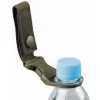
Close up.
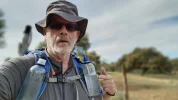
Once you know the best placement for the clips, you could sew them in place.
Can't see it in this picture, but the clip for my umbrella is actually sewn onto the pack strap in just the right place.
I have had one of these clips gradually get loose, (plastic fatigue) so I now carry a spare.
The drinking tube I have kept full length and it goes around across the top of the pack to the other side.
Again, it fits neatly under the load lifters and stays in place.
LouLou
Member
- Time of past OR future Camino
- ‘2004’, '2009', '2018 C. Frances (SJPD-SDC)
'2018' C. via de la Plata (Merida)
'2019' C. Portugues
Can't agree more Robbo. I have an Aarn pack with front poI have used both bladders and bottles with drinking tube.
Ensuring adequate hydration is essential, and both methods allow for sufficient water to be carried.
By using a drinking tube, both methods allow for easy water access.
But which one allows for easy monitoring of consumption and water levels?
Front mounted water bottles….
For that reason alone I don’t use bladders any more.
On longer stretches, or more remote Caminos I would be forever digging into my pack to check water levels. That fear of running out, when using a bladder, caused me to carry too much water (weight).
Front mounted bottles, always in sight, allow precise monitoring, and I find encourages better hydration. I can drink to my planned consumption level freely, without worrying about how much water remains.
I loved bladders initially, but no way I would use them again.
I now remain fully hydrated, and don’t run out. (and don't end up carrying extra water)
ckets, so super easy. I also like the tube that you screw into plastic bottles. So much easier than bladder cleaning ( and yes I do reuse the bottles).
LouLou
Member
- Time of past OR future Camino
- ‘2004’, '2009', '2018 C. Frances (SJPD-SDC)
'2018' C. via de la Plata (Merida)
'2019' C. Portugues
I do, love it!My 2L water bladder weighs 165 gms.
My 2 x 1L bottles weigh 50 gms.
Though to be fair in comparison, my drinking tube weighs 70 gms.
I just 'pop' in the mouthpiece and drink
It's not so much about the weight.
Though bottles are lighter.
They have the same convenience, using a tube.
For me it's all about visibility.
I have a 'water gauge' sitting in front of me.
But hey, like any other gear, we all have our preferences.
Though I'm surprised I don't see many people using a drinking tube with bottles?
Train for your next Camino on California's Santa Catalina Island March 16-19
excellent points markos!I have walked with and without the bladder.
I am a NO
reasons
1 you can sip but don’t know how much you have consumed. Can be way out
2 difficult to refill
3 if it’s 2-3 l that’s a lot of weight. 2-3 kgs
4 in many parts of the Camino there is abundant water. Even heading over the Pyrenees there are 3 places to top up.
5 a 500ml water bottle on each hip provides balance and usually enough.
Yes there are exceptions such as long stretches on the VDLP. Then you need a different strategy
My advice is to keep the weight down and check each days distance and plan water appropriately
Cheers
Mark O
Jeff Crawley
Veteran Member
- Time of past OR future Camino
- A "Tourigrino" trip once Covid has passed, so 2023
Have a glance at this Water IntoxicationIMHO drinking is also some form of self-control. I am notoriously guilty of not drinking enough water during my 'regular' days. Somehow I've learnt to know better when i walk. I trained myself to take that pull on the tube within some time. I trained for it some years ago by setting up an alarm in my phone that "yelled" at me every 15 mins "DRINK WATER!" and sort of got into a habit...
Yeah I heard about it on the Camino from one Belgian Lady. Although she absolutely seriously told me that if you drink 10L of water you will die.
3rd Edition. More content, training & pack guides avoid common mistakes, bed bugs etc
RibbonRomanceAuthor
Active Member
- Time of past OR future Camino
- Caminos Frances, Norte and Ingles June-July 2022
I knew from prior experience with using a bladder on a long distance walk that they did not work for me. I could not get the bite valve thing so water constantly soaked me. While that may have felt good on a hot day, in reality it was a pain. For one thing. water did not osmose into me from my wet clothes, but I had to keep refilling it. For me, that was a clumsy waste of time. It was a pain to clean also and I can't imagine that cleaning would be a simple thing to do in an albergue.
So, bottles for me and I had zero problems with them on my Camino.
So, bottles for me and I had zero problems with them on my Camino.
- Time of past OR future Camino
- Us:Camino Frances, 2015 Me:Catalan/Aragonese, 2019
Jeff Crawley
Veteran Member
- Time of past OR future Camino
- A "Tourigrino" trip once Covid has passed, so 2023
I remember seeing the result of an online poll, the question asked being "Would you wear a facemask if it was not mandated by law?"So 50% say no and the other 56% answered differently.
View attachment 180423
P.S. Image was submitted as a thumbnail and acts like a thumbnail yet isn't scaled like a thumbnail.
The result came in a resounding 100% NO
One person voted.
Join the Camino cleanup. Logroño to Burgos May 2025 & Astorga to OCebreiro in June
- Time of past OR future Camino
- CF, CP, VDLP, VK
I have an Aarn pack and find the bottles fit on the side of the pack perfectly leaving the balance pockets free.Can't agree more Robbo. I have an Aarn pack with front po
ckets, so super easy. I also like the tube that you screw into plastic bottles. So much easier than bladder cleaning ( and yes I do reuse the bottles).
- Time of past OR future Camino
- Various routes 2016 - 2024
@ivar has changed some settings for uploaded photos. One was to increase the size of thumbnails. They don't really need to be clicked on to view the image well and they should load faster.P.S. Image was submitted as a thumbnail and acts like a thumbnail yet isn't scaled like a thumbnail.
- Time of past OR future Camino
- Frances ' 22, Madrid '24, Frances '24
Sounds like what I want. Do you have a link or image of what you use? Is it something you can attach to any any pack or…?Front mounted bottles
The one from Galicia (the round) and the one from Castilla & Leon. Individually numbered and made by the same people that make the ones you see on your walk.
- Time of past OR future Camino
- Various routes 2016 - 2024
Sounds like what I want. Do you have a link or image of what you use? Is it something you can attach to any any pack or…?
Lots of info in this post
Just Google "water bottle clip"
Lots of different types.
Mine are like this. Just fit them to the pack straps.
I also use an elastic cord around my pack straps and the bottle to hold it in place.
I use elasticated shoe laces..... (blue cord in pic below)
It all stays in place nicely.
The bottles only come off for cleaning and filling.
If it's hot, on some days I might fill one side (non tube side) with Aquarius.
Don't want to gunk up the tube.
To drink from that one I just unclip the bottle. Takes 1 sec!
So you don't really even need the tube, but I prefer it.
It's 'hands free'.
View attachment 180404
Close up.
View attachment 180405
Once you know the best placement for the clips, you could sew them in place.
Can't see it in this picture, but the clip for my umbrella is actually sewn onto the pack strap in just the right place.
I have had one of these clips gradually get loose, (plastic fatigue) so I now carry a spare.
The drinking tube I have kept full length and it goes around across the top of the pack to the other side.
Again, it fits neatly under the load lifters and stays in place.
- Time of past OR future Camino
- 2017, 2018, 2019, 2025
I appreciate it when there is a lot of experienced equipment users contributing their personal insights on what gear they prefer and the reasons for that choice. This is a significant reason why this Forum is unique in wanting to help the novice/newbie sort things out.
In reading through the various posts, this thread contains a lot of correct information, a ton of opinion based on personal bias/preference, and a goodly bit of myth, misinformation, and missing information.
A link to a post I had written on this subject was already posted by Trecile so I won't repost it here.
The purpose of that posting was not to dictate a specific recommendation on what method is 'best' for all persons who will be carrying water, (though I mention reasons for what I find most useful and usable for me). That post was created to correct misinformation, add insights, and provide lesser known information and resources about water reservoirs/bladders, so that those seeking to make an evaluative choice on how they want to carry water have an objective basis for looking at the gear. From there, it becomes a subjective choice based on personal preferences with usability, and what 'feels' most comfortable to the individual.
What 'form' one's choice of water-carrying gear takes - and the reasons behind that choice - are far less important than understanding the principles and need for remaining adequately hydrated during times of high-exertion activities. This would include clearly understanding how to properly evaluate the amounts of water one should carry based on things like weather, distances between potable water sources for resupply, and individual bodily needs.
Love you all.
In reading through the various posts, this thread contains a lot of correct information, a ton of opinion based on personal bias/preference, and a goodly bit of myth, misinformation, and missing information.
A link to a post I had written on this subject was already posted by Trecile so I won't repost it here.
The purpose of that posting was not to dictate a specific recommendation on what method is 'best' for all persons who will be carrying water, (though I mention reasons for what I find most useful and usable for me). That post was created to correct misinformation, add insights, and provide lesser known information and resources about water reservoirs/bladders, so that those seeking to make an evaluative choice on how they want to carry water have an objective basis for looking at the gear. From there, it becomes a subjective choice based on personal preferences with usability, and what 'feels' most comfortable to the individual.
What 'form' one's choice of water-carrying gear takes - and the reasons behind that choice - are far less important than understanding the principles and need for remaining adequately hydrated during times of high-exertion activities. This would include clearly understanding how to properly evaluate the amounts of water one should carry based on things like weather, distances between potable water sources for resupply, and individual bodily needs.
Love you all.
- Time of past OR future Camino
- Frances\Finisterre 22 Frances 26 del Norte 27
Oh i never doubted that it exists. As the referenced article and @trecile stated kidneys process appr. 1L\hrHave a glance at this Water Intoxication
Considering my self-admitted habit of NOT drinking enough I dont think I'd ever get to that stage. On the average through my 6-8hr daily walk I would consume close to 2L of water I carried and maybe 2 more Kaz Lemons.
I think i was intoxicated by the Camino itself
Ideal sleeping bag liner whether we want to add a thermal plus to our bag, or if we want to use it alone to sleep in shelters or hostels. Thanks to its mummy shape, it adapts perfectly to our body.
€46,-
€46,-
❓How to ask a question
How to post a new question on the Camino Forum.
Most read last week in this forum
I did a search typing GPS and read many informative posts.
It seems from what I have read that the route for the Camino Frances is well marked and I hope that is true.
QUESTION: Even so, in...
Hi! I will do the fishermans trail and then the nascente.
I dont have a lot of money, so I'm hoping to camp (with permission) most nights
Is it possible to send a parcel containing camping gas...
I am walking the Camino Frances for the whole month of May (April 22nd - June 1st), and am wondering whether I should opt for waterproof shoes/boots? I have seen mixed messages online - on the one...
For those who use Wikiloc, is there a way to measure the distance between waypoints on a trail someone has uploaded? If I want to break my stages differently than the person who uploaded them did...
Similar threads
- Replies
- 71
- Views
- 5K
- Locked
- Poll
- Replies
- 241
- Views
- 19K
- Replies
- 60
- Views
- 7K
- Replies
- 40
- Views
- 4K
- Replies
- 34
- Views
- 3K
❓How to ask a question
How to post a new question on the Camino Forum.
Most downloaded Resources
-
“All” Albergues on the Camino Frances in one pdf“All” Albergues on the Camino Frances in one pdf
- ivar
- Updated:
-
A selection of favorite albergues on the Camino FrancésFavorite Albergues along the Camino Frances
- Ton van Tilburg
- Updated:
-
Profile maps of all 34 stages of the Camino FrancesProfile maps of all 34 stages of the Camino Frances
- ivar
- Updated:


